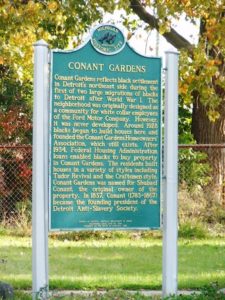
*Conant Gardens is celebrated on December 2, 1928. This is a Black neighborhood in northeast Detroit, Michigan.
Due to the automobile industry boom, the community was not very densely populated until the 1920s. Named after reluctant abolitionist Shubael Conant, Conant Gardens was to be developed for white-collar Ford workers, but there was a lack of interest. However, the industrial boom also led to a large, prosperous black population who could not find neighborhoods in which they could safely live due to violence and covenant restrictions.
Around 1928, several Blacks took advantage of the area's lack of deed restrictions for those wishing to purchase property. Historically, the neighborhood was the most prosperous Black neighborhood in that city, and its residents were the most highly educated. Conant Gardens is in northeast Detroit, Michigan, just west of Detroit's Krainz Woods neighborhood. It is between Conant Street and the City of Highland Park, north of Hamtramck.
Seven Mile Road was the boundary between Conant Gardens and a White working-class area. The neighborhood boundaries are Conant Street, East Seven Mile, Ryan Road, and East Nevada Street. It is located almost 8 miles from Paradise Valley. Due to its proximity to Krainz Woods, the neighboring community is sometimes mistaken for being within Conant Gardens. Pershing High School is located in Conant Gardens, near the residential area.
In the early 1940s, the community protested against constructing the Sojourner Truth Housing project, a federally funded public housing project. The residents of Conant Gardens allied with nearby white homeowners associations; Thomas J. Sugrue, author of The Origins of the Urban Crisis: Race and Inequality in Postwar Detroit, characterizes the alliance as "unlikely." In 1966, the Whites in Krainz Woods wanted to recruit middle-class Blacks in Conant Gardens to oppose public housing. In a Black newspaper, the Krainz Woods Neighborhood Organization posted an advertisement asking Conant Gardens residents to meet at an area church to protest a proposed scattered-site housing and open occupancy.
Thomas J. Sugrue, the author of The Origins of the Urban Crisis: Race and Inequality in Postwar Detroit, said that in its heyday, Conant Gardens was "more suburban than urban, surrounded by open fields and remote from the city's business and industrial districts." The neighborhood had single-family detached houses, many of which had large lawns. The streets were lined with trees. Sugrue said the houses were modern, the lawns were "well-manicured," and the roads were "quiet." In the 1940s and 1950s, many residents moved to Conant Gardens. They included business people, lawyers, ministers, and teachers.
In 1950, all neighborhoods with over 500 Black persons, the median income of Black families and unrelated individuals of tracts 603 and 604, respectively, were the highest in Detroit; the tracts correspond to Conant Gardens. That year, 60% of the residents owned their houses. Historically, the residents had covenants that banned multi-family housing and other "undesirable uses" from Conant Gardens but never had deed restrictions that prohibited Black people from living there. In 2001, the Conant Gardeners Club was writing a book about the neighborhood.
It is zoned to Detroit Public Schools. Residents are zoned to Mason K-8 School for elementary and middle school. All residents are zoned to Pershing High School. The current Mason was the former Farwell Elementary-Middle School. The previous Mason Elementary School closed in 2012 and consolidated into Farwell. Previously, Conant Gardens was zoned to Atkinson Elementary School. At a later point, it was zoned to Van Zile Elementary School. Residents were previously zoned to Farwell K-8 for middle school.